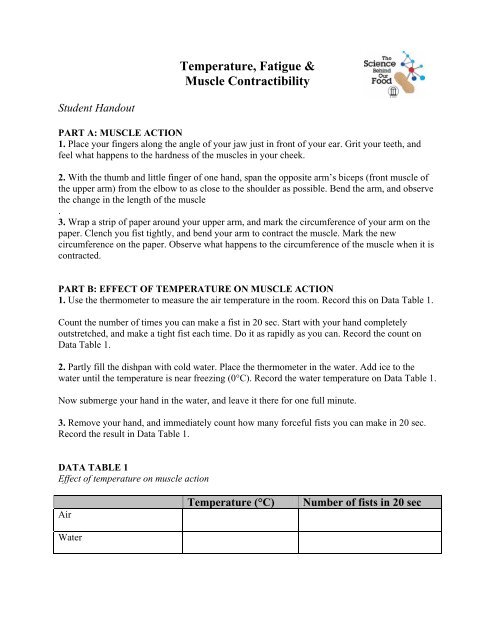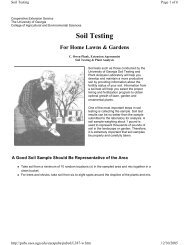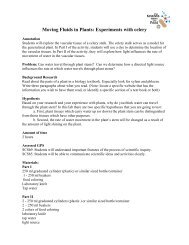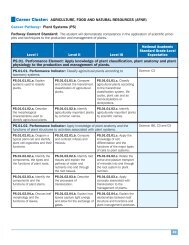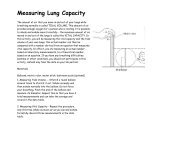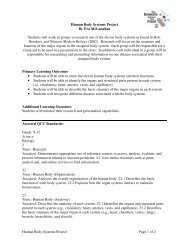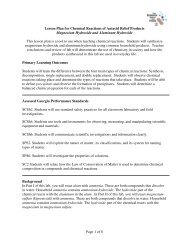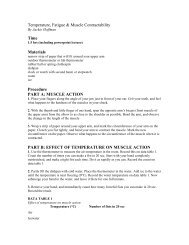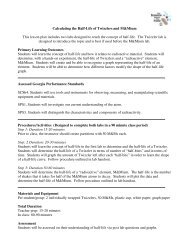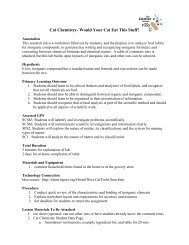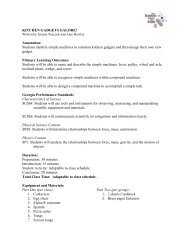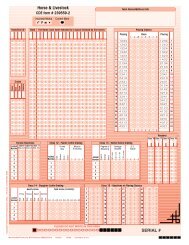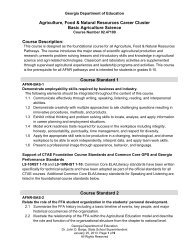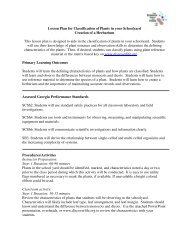Temperature, Fatigue & Muscle Contractibility
Temperature, Fatigue & Muscle Contractibility
Temperature, Fatigue & Muscle Contractibility
- No tags were found...
Create successful ePaper yourself
Turn your PDF publications into a flip-book with our unique Google optimized e-Paper software.
<strong>Temperature</strong>, <strong>Fatigue</strong> &<strong>Muscle</strong> <strong>Contractibility</strong>Student HandoutPART A: MUSCLE ACTION1. Place your fingers along the angle of your jaw just in front of your ear. Grit your teeth, andfeel what happens to the hardness of the muscles in your cheek.2. With the thumb and little finger of one hand, span the opposite arm’s biceps (front muscle ofthe upper arm) from the elbow to as close to the shoulder as possible. Bend the arm, and observethe change in the length of the muscle.3. Wrap a strip of paper around your upper arm, and mark the circumference of your arm on thepaper. Clench you fist tightly, and bend your arm to contract the muscle. Mark the newcircumference on the paper. Observe what happens to the circumference of the muscle when it iscontracted.PART B: EFFECT OF TEMPERATURE ON MUSCLE ACTION1. Use the thermometer to measure the air temperature in the room. Record this on Data Table 1.Count the number of times you can make a fist in 20 sec. Start with your hand completelyoutstretched, and make a tight fist each time. Do it as rapidly as you can. Record the count onData Table 1.2. Partly fill the dishpan with cold water. Place the thermometer in the water. Add ice to thewater until the temperature is near freezing (0°C). Record the water temperature on Data Table 1.Now submerge your hand in the water, and leave it there for one full minute.3. Remove your hand, and immediately count how many forceful fists you can make in 20 sec.Record the result in Data Table 1.DATA TABLE 1Effect of temperature on muscle actionAirWater<strong>Temperature</strong> (°C)Number of fists in 20 sec
PART C: EFFECT OF FATIGUE ON MUSCLE ACTION1. Count how many times you can tightly squeeze a rubber ball in your hand in 20 seconds(Alternatively, count how many times you can open and close a spring clothespin with the thumband index finger while the other fingers are held out straight.) Record the result on data table 2 inthe space alongside trial 1.2. Repeat the squeezing test for nine more 20-sec trials, and record your results on data table 2.Do not rest between trials.3. In Part A, what are the three changes you observed in a muscle while it is working(contracted)?1. ________________________________________________________2. ________________________________________________________3. ________________________________________________________4. What effect did the cold temperature have on the action of your hand muscles in Part B?Explain.DATA TABLE 2Effect of fatigue on muscle actionTrial Number Number of Contractions in 20 seconds12345678910
5. Make a line graph of your results of the fatigue experiment in Part C of the procedure. Placetrials 1 to 10 on the horizontal axis. On the vertical axis, use numbers to represent number ofactions performed. Choose a scale that will allow you to graph the results you got for each of the10 trials recorded on data table 2. Plot a point for each trial’s result, and draw a line connectingthe points. What does the graph show about the results of the experiment?6. What effect did fatigue have on the action of your hand muscles? Explain.


